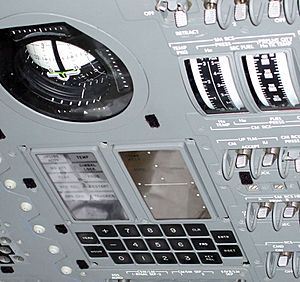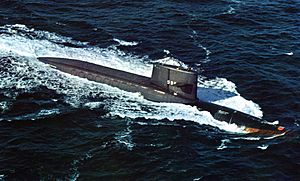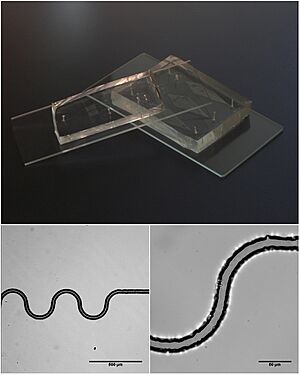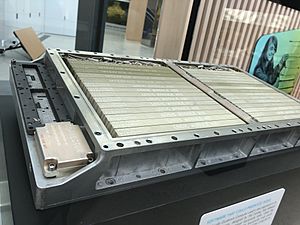Draper Laboratory facts for kids
 |
|
| Independent, non-profit corporation | |
| Industry | Defense Space Biomedical Energy |
| Founded | MIT Confidential Instrument Development Laboratory (1932) The Charles Stark Draper Laboratory, Inc. (1973) |
| Headquarters | 555 Technology Square, Cambridge, MA 02139-3563 |
|
Number of locations
|
4 |
|
Key people
|
Dr. Jerry M. Wohletz, President and CEO (2022–) |
| Revenue | $765 million (fiscal year 2023) |
|
Number of employees
|
2,000 |
Draper Laboratory is a special place in Cambridge, Massachusetts, where smart people work on amazing new technologies. It's a non-profit organization, which means it focuses on research and development rather than making money for owners. Its official name is The Charles Stark Draper Laboratory, Inc.
Draper Laboratory creates advanced technology solutions for many important areas. These include national security, exploring space, improving healthcare, and finding better ways to use energy.
The laboratory was started in 1932 by Charles Stark Draper, a professor at the Massachusetts Institute of Technology (MIT). He wanted to develop tools for airplanes. It was first called the MIT Instrumentation Laboratory. A famous project from this time was the Apollo Guidance Computer. This was the first computer to use tiny silicon integrated circuits. It helped guide astronauts to the Moon!
In 1970, the lab was renamed after its founder. Then, in 1973, it became its own independent, non-profit organization, separate from MIT. The experts at Draper Laboratory work on things like guidance systems, navigation, control technologies, and advanced computer programs. They also work with tiny machines called microelectromechanical systems.
Contents
History of Draper Laboratory
In 1932, Charles Stark Draper, who taught about airplanes at MIT, started a lab. His goal was to create tools for tracking, controlling, and navigating aircraft. During World War II, his lab was known as the Confidential Instrument Development Laboratory. Later, it became the MIT Instrumentation Laboratory, or I-Lab.
In 1970, the lab was renamed after Charles Stark Draper. It stayed part of MIT until 1973. Then, it became an independent, non-profit research group. This change happened because of pressure during the Vietnam War. Some people wanted MIT labs to stop doing military research. Even though Draper Lab wasn't involved in that war, it still became separate.
After leaving MIT, the lab moved to a new, large building in 1976. This building was designed to bring all their work into one place. In 1984, another building was added and connected by a special walkway.
However, in 1989, Draper Lab had to reduce its staff by half. This was because the government cut back on defense funding. To adapt, Draper started working on new areas. These included space exploration, energy, medicine, and artificial intelligence. This helped the lab grow back to a large size within ten years.
In 2017, an open area between the main buildings was turned into a large, bright indoor space. This new area is used for security, welcoming visitors, and employee dining. It has a beautiful green wall of plants.
Throughout its history, a main focus for Draper has been developing advanced guidance, navigation, and control (GN&C) technologies. These technologies help the US Department of Defense and NASA. Draper's achievements include creating accurate guidance systems for missiles launched from submarines. They also made the Apollo Guidance Computer that safely guided the Apollo astronauts to the Moon and back.
The lab also helped create systems for planes, submarines, missiles, spacecraft, and uncrewed vehicles. These systems were key for submarines to navigate underwater for long periods without being found. They also guided missiles to their targets. A famous team led by Margaret Hamilton wrote the software for the Apollo missions.
Where Draper Laboratory Works
Draper has offices in several cities across the United States:
- Cambridge, Massachusetts (this is their main office)
- Houston, Texas (near NASA Johnson Space Center)
- Reston, Virginia
- Odon, Indiana
- Washington, DC (at the Washington Navy Yard)
- Huntsville, Alabama (near NASA’s Marshall Space Flight Center)
- St. Petersburg, Florida
- Pittsfield, Massachusetts
- Cape Canaveral, Florida
What Draper Laboratory Does
Draper Laboratory uses its knowledge to work on many exciting projects. These include:
- Autonomous Systems: Creating robots and vehicles that can move and make decisions on their own, whether in the air, on land, in the sea, or in space.
- Information Integration: Combining information from different sources to make it useful.
- Sensors and Networks: Developing tiny sensors and systems that can work together.
- Precision-Guided Weapons: Making weapons that can hit their targets very accurately.
- Biomedical Engineering: Using engineering to solve problems in medicine and health.
- Chemical/Biological Defense: Protecting against dangerous chemical or biological threats.
- Energy Systems: Creating models and managing systems for generating and using energy.
Draper Laboratory has seven main areas of special expertise:
Strategic Systems
This area uses guidance, navigation, and control (GN&C) skills for advanced GPS technologies. They also work on submarine navigation and keeping strategic weapons safe.
Space Systems
Draper is a partner with NASA for developing technology for space exploration. They create GN&C systems and high-performance science tools. They also work on space projects for national security.
Tactical Systems
This team develops systems for watching and understanding what's happening at sea. They also make small guidance systems for munitions and guided delivery systems for supplies. They create secure electronics and communication tools, and systems to help soldiers.
Special Programs
This group develops new ideas, builds early versions (prototypes), and helps with new systems. They connect with all the other technical areas.
Biomedical Systems
This area focuses on tiny machines called Microelectromechanical systems (MEMS). They also work on microfluidics, which is about controlling tiny amounts of liquids for medical uses. This includes creating small, smart medical devices.
Air Warfare and ISR
This team develops technology to help with targeting and planning for air missions. ISR stands for Intelligence, Surveillance, and Reconnaissance.
Energy Solutions
This group works on making energy systems more reliable, efficient, and better performing. This includes everything from large coal-fired power plants to the International Space Station.
Cool Projects at Draper Laboratory
Draper Laboratory is known for its work in inertial navigation. This is a way to guide vehicles without needing outside signals. More recently, they've been working on new ways to navigate in space, smart systems that use sensors, and tiny medical devices.
Draper has studied how to combine Global Positioning System (GPS) signals with Inertial navigation systems (INS). This makes navigation cheaper and more reliable. Military systems can't always rely on GPS because signals can be blocked. So, they need INS, which can work on its own. Less accurate INS systems are cheaper but need GPS updates more often. Draper has developed ways to deeply integrate GPS with INS.
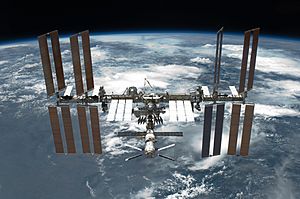
In 2010, Draper Laboratory worked with MIT and other partners on the Next Giant Leap team. They won a grant to send a robot to the Moon as part of the Google Lunar X Prize. The robot needed to travel 500 meters on the Moon and send back video and data. The team created a special simulator to practice in a low-gravity environment.
In 2012, Draper engineers in Houston found a new way to turn the International Space Station. This "optimal propellant maneuver" saved 94 percent of the fuel compared to older methods. The computer program considers everything that affects how the station moves.
Draper has also been developing a special suit for astronauts to wear in orbit. This suit uses small devices called Controlled Moment Gyros (CMGs). These CMGs create resistance when an astronaut moves their limbs. This helps prevent bone loss and keeps muscles strong during long space flights. The suit, called the V2Suit, also helps with balance by creating an artificial sense of "down."
In 2013, a team from Draper, MIT, and NASA worked on a spacesuit with CMGs. This suit would improve NASA's "Simplified Aid for EVA Rescue" (SAFER) system. SAFER helps astronauts get back to their spacecraft if they float away. The CMG-enhanced suit would provide better counterforce. On Earth, gravity provides counterforce when you use tools. In space, without gravity, using a tool could send an astronaut spinning. CMGs would help prevent this.
Lunar Lander Missions
On November 29, 2018, NASA chose Draper Laboratory as a contractor for its Commercial Lunar Payload Services (CLPS) program. This means Draper can bid to deliver science and technology to the Moon for NASA. Draper proposed a lunar lander called Artemis-7. The number 7 means it would be the seventh lunar lander mission Draper has been involved in, after the six Apollo Moon landings. The lander design is based on one from a Japanese company called ispace. As of 2025, Draper and ispace are developing a lunar lander called APEX 1.0. It is planned to deliver CLPS payloads to the Moon in 2026.
Intelligent Systems
Draper researchers are developing artificial intelligence systems that allow robots to learn from their mistakes. This work helps the Army's Future Combat System. For example, a robot under fire could learn that a road is dangerous and find a safer path.
Since 2009, the US Department of Homeland Security has funded Draper Laboratory to develop a technology called Future Attribute Screening Technology (FAST). This system uses cameras and sensors to monitor people at security checkpoints. It helps identify behaviors that might suggest someone has bad intentions.
In 2010, Draper Laboratory was involved in the Nano Aerial Vehicle (NAV) program. This program aims to create tiny flying robots for reconnaissance. These NAVs need to work on their own in cities where GPS signals might not be available. They use vision-based sensors to navigate.
Medical Systems
In 2009, Draper worked with the Massachusetts Eye and Ear Infirmary to create an implantable device that delivers medicine. This device combines tiny machines (MEMS) with microfluidics, which controls liquids on a very small scale. It's a flexible machine with tiny tubes that expand and contract to move fluid. This system could help treat hearing loss by delivering small amounts of medicine to a delicate part of the ear. This could help sensory cells regrow and restore hearing.
Since 2010, Heather Clark at Draper Laboratory has been working on a way to measure blood glucose without needing to prick a finger. This method uses a tiny nano-sensor, like a miniature tattoo, that patients put on their skin. The sensor uses light to figure out glucose levels. This could make it much easier for diabetics to manage their blood sugar.
Amazing Innovations from Draper Lab
Draper Laboratory staff have worked in teams to create many new navigation systems. These systems use inertial guidance and digital computers to figure out where things are in space.
- Mark 14 Gunsight (1942): This improved how accurately anti-aircraft guns hit targets on ships during World War II.
- Space Inertial Reference Equipment (SPIRE) (1953): This was an autonomous navigation system for aircraft that worked on its own.
- The Laning and Zierler system (1954): An early computer program that helped with math problems.
- Q-guidance: A special method for guiding missiles.
- Apollo Guidance Computer: The first computer used in space that relied on tiny integrated circuits for navigation.
- Digital fly-by-wire: A control system that lets pilots control an aircraft using electronics, without mechanical connections.
- Fault-tolerant Computing: A system where several computers work on a task at the same time. If one computer fails, the others can take over. This is very important for safety in aircraft.
- Micro-electromechanical (MEMS) technologies: Tiny mechanical systems, including the first micromachined gyroscope.
- Autonomous systems algorithms: Computer programs that allow spacecraft to meet and connect on their own, and for underwater vehicles to navigate.
- GPS combined with inertial navigation system: A way to keep navigating even when a vehicle or system enters an area where GPS signals are blocked.
Draper's Community Programs
Draper Laboratory also helps develop and recognize talented people through educational programs and public events. They also support the Charles Stark Draper Prize, which is like a "Nobel Prize of Engineering."
Public Exhibitions
Sometimes, Draper Laboratory hosts free exhibitions and events for the public. These are held in special areas at their main building. For example, in 2019, Draper celebrated the 50th anniversary of the first Apollo Moon landing. The exhibition, called Hack the Moon, showed artifacts like the Apollo Guidance Computer hardware. Visitors could even try landing the Apollo Lunar Module on a simulator!
Other exhibitions have shown different research projects at Draper. All visitors go through a security scanner, like at airports.
Helping with Education
The Draper Fellow Program supports about 50 graduate students each year. These students are trained to become leaders in government, military, industry, and education. The lab also supports research at universities. They offer jobs and internships for college students.
Draper Laboratory has a STEM (Science, Technology, Engineering, and Mathematics) program for kids from kindergarten to high school. They started this program in 1984. Each year, they give over $175,000 to community programs. This money helps with internships, science festivals, tours, and speakers.
Since 2021, Draper Laboratory has also sponsored Draper Spark!Lab. This is at the National Museum of American History in Washington, DC. It's a free, hands-on invention space for children aged 6 to 12.
The Draper Prize
The company funds the Charles Stark Draper Prize. This award is given to recognize amazing engineering achievements. It celebrates innovations that have helped humanity and improved our lives. The prize is $500,000 and can be given for achievements in any area of engineering.
See also
 In Spanish: Laboratorio Draper para niños
In Spanish: Laboratorio Draper para niños
- List of United States college laboratories conducting basic defense research
- Bell Labs
- Massachusetts Institute of Technology
- David Hoag


